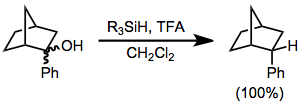Reactions and applications
Setting aside silane itself, for which is used mainly in the microelectronics industry as a source of Si, hydrosilanes participate in many reactions. Hydrosilanes are mainly used for diverse styles of reduction in both industrial and laboratory-scale reactions. These including deoxygenation, hydrosilylation, and ionic hydrogenation.
Hydrosilylation
SIn hydrosilylation, the Si-H bond adds across multiple bonds in alkenes, alkynes, imines, and carbonyls. The reaction of alkenes is commercially significant. Many organosilicon compounds and materials are prepared in this way. Illustrative is the crosslinking of vinyl-terminated siloxanes:

Conversion to silanols
In the presence of platinum-based catalysts, hydrosilanes react with water to give silanols:
- R3SiH + H2O → R3SiOH + H2
The same transformation can be effected with oxygen in the presence of catalysts. [2]
Fluoride complexes
In the presence of fluoride ions, hydrosilanes reversibly form hypervalent fluorosilicates with the formula R3Si(F)H−). These species are reducing agents, akin to borohydride. [3] [4]

Ionic hydrogenation
Reductions with hydrosilanes are a subset of ionic hydrogenations. In this type of reaction, carbocations are generated by the action of strong Lewis or Brønsted acids in the presence of hydrosilanes, which then transfer hydride. A typical acid is trifluoroacetic acid (TFA).
The reaction is stoichiometric.
Deoxygenation and ionic hydrogenation
Hydrosilanes are used for the deoxygenation of phosphine oxides and sulfoxides. [5]
Hydrosilanes serve as hydride donors in some ionic hydrogenations.

Coordination the metals
Hydrosilanes form sigma complexes with unsaturated metals. The bonding is similar to that in dihydrogen complexes but stronger. One example is (CH3C5H4)Mn(CO)2(H2SiPh2). [6] Such adducts represent models for and competitors with the oxidative addition of the Si-H bond.
Reduction of or addition to organic substrates
Akin to the hydrosilylation of alkenes, hydrosilanes add to a variety of unsaturated substrates.
In one example, PMHS. In one study triethylsilane is used in the conversion of a phenyl azide to an aniline: [7]
In this reaction ACCN is a radical initiator and an aliphatic thiol transfers radical character to the silylhydride. The triethylsilyl free radical then reacts with the azide with expulsion of nitrogen to a N-silylarylaminyl radical which grabs a proton from a thiol completing the catalytic cycle:


